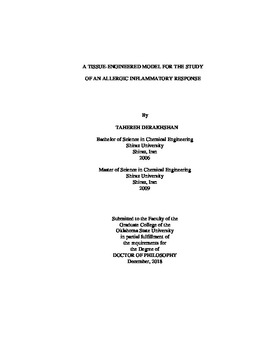| dc.description.abstract | Allergy occurs when the immune system overreacts to allergens. Worldwide, up to 40% of the population suffers from different types of allergies. In severe cases, allergic reactions can lead to death. Therefore, determining the factors that are involved in the development of an allergic immune response is critical. Mast cells (MCs) are the foremost inducers of allergic responses, but their role in the initiation of the response is not well understood. Due to the effect of the extracellular matrix components on the tissue morphogenesis and cell behavior, utilizing a tissue model that closely mimics MC microenvironmental conditions in vivo has greater relevance for in vitro studies. Therefore, our goal was to develop a tissue-engineered model to determine the role of MCs in orchestrating an immune response by investigating the interaction between MCs and monocytes in response to an allergen, and the corresponding effect on lymphocyte function in an IgE-independent manner. The tissue-engineered model is comprised of two separate modules that together recapitulate an allergic response. In the first module, MCs were generated from progenitor cells in the presence of fibroblasts and endothelial cells. Endothelial cells are involved in leukocyte recruitment during inflammation and, along with fibroblasts, support the development of MCs. Generated cells within the tissue model exhibited MC morphology, immunophenotype, and released histamine in IgE-mediated reactions, showing typical MC functional phenotype in immediate-type allergenic responses. Monocytes, in response to the allergen activated model, differentiated into CD1c+ cells, displaying immunophenotypic characteristics of dendritic cells. However, MCs mitigated the effect of the allergen on the development of CD1c+ cells and marginally influenced the expression of the molecules required for T cell activation. In the second module, monocyte-derived cells triggered the proliferation of T and B cells. MCs indirectly induced the emergence of IgE-producing plasma cells indicating that MCs can play a role in the initiation of an allergic response. In addition to investigating the mechanism of an allergic response, the tissue-engineered model can be used as a tool for personalized diagnosis of allergies, testing the effect of drugs for allergy treatment, and for studying other inflammatory disorders, such as asthma and angiogenesis. | |
